Perceptions, Vulnerability and Adaptation Strategies for Mitigating Climate Change Effects among Small Livestock Herders in Punjab, Pakistan
Abstract
:1. Introduction
Vulnerability Assessment
2. Materials and Methods
2.1. Study Area, Sampling and Data Collection Method
2.2. Climate Change Risk Perception Index
2.3. Vulnerability Index
2.4. Drivers of Adoption
3. Results
3.1. Socio-Demographic Characteristics of Study Participants
3.2. Livestock Herders’ Climate Change Perceptions and Meteorological Data
3.3. Contributing Factors of Vulnerability
3.3.1. Exposure Assessment
3.3.2. Sensitivity Assessment
3.3.3. Adaptive Capacity Assessment
3.4. Vulnerability Index Assessment
3.5. Drivers Influencing Herders’ Adaptations
4. Discussion
5. Conclusions
Study limitations
Author Contributions
Funding
Institutional Review Board Statement
Informed Consent Statement
Data Availability Statement
Conflicts of Interest
References
- Fahad, S.; Wang, J. Farmers’ risk perception, vulnerability, and adaptation to climate change in rural Pakistan. Land Use Policy 2018, 79, 301–309. [Google Scholar] [CrossRef]
- IPCC Impacts, Adaptation, and Vulnerability: Contribution of working group II to the fifth assessment report of the Intergovernmental Panel on Climate Change. Intergov. Panel Clim. Chang. 2014, 1–44. Available online: https://epic.awi.de/id/eprint/37530/ (accessed on 15 December 2020).
- Kohler, T.; Maselli, D. Mountains and Climate Change—From Understanding to Action; Geographica Bernensia: Bern, Switzerland, 2009; ISBN 9783905835168. [Google Scholar]
- Dendir, Z.; Simane, B. Livelihood vulnerability to climate variability and change in different agroecological zones of Gurage Administrative Zone, Ethiopia. Prog. Disaster Sci. 2019, 3, 100035. [Google Scholar] [CrossRef]
- Jamshidi, O.; Asadi, A.; Kalantari, K.; Azadi, H.; Scheffran, J. Vulnerability to climate change of smallholder farmers in the Hamadan province, Iran. Clim. Risk Manag. 2019, 23, 146–159. [Google Scholar] [CrossRef]
- Faisal, M.; Chunping, X.; Akhtar, S.; Raza, M.H.; Khan, M.T.I.; Ajmal, M.A. Modeling smallholder livestock herders’ intentions to adopt climate smart practices: An extended theory of planned behavior. Environ. Sci. Pollut. Res. 2020, 27, 39105–39122. [Google Scholar] [CrossRef]
- Lindoso, D.P.; Rocha, J.D.; Debortoli, N.; Parente, I.C.I.; Eiró, F.; Filho, S.R. Indicators for assessing the vulnerability of smallholder farming to climate change: The case of Brazil’s semi-arid northeastern region. Int. Policy Cent. Incl. Growth 2012. Available online: https://research.rug.nl/en/publications/indicators-for-assessing-the-vulnerability-of-smallholder-farming (accessed on 15 December 2020).
- Omerkhil, N.; Chand, T.; Valente, D.; Alatalo, J.M.; Pandey, R. Climate change vulnerability and adaptation strategies for smallholder farmers in Yangi Qala District, Takhar, Afghanistan. Ecol. Indic. 2020, 110, 105863. [Google Scholar] [CrossRef]
- Alam, M.M.; Siwar, C.; Talib, B.A.; Wahid, A.N.M. Climatic changes and vulnerability of household food accessibility: A study on Malaysian East Coast Economic Region. Int. J. Clim. Chang. Strateg. Manag. 2017, 9, 387–401. [Google Scholar] [CrossRef]
- Fang, Z.; Cao, C. The State of Food Security and Nutrition in the World 2019. Building Climate Resilience for Food Security and Nutrition; FAO: Rome, Italy, 2019; Volume 7, ISBN 9789251315705. [Google Scholar]
- Faisal, M.; Abbas, A.; Chunping, X.; Haseeb Raza, M.; Akhtar, S.; Arslan Ajmal, M.; Mushtaq, Z.; Cai, Y. Assessing small livestock herders’ adaptation to climate variability and its impact on livestock losses and poverty. Clim. Risk Manag. 2021, 34, 100358. [Google Scholar] [CrossRef]
- Harvey, C.A.; Rakotobe, Z.L.; Rao, N.S.; Dave, R.; Razafimahatratra, H.; Rabarijohn, R.H.; Rajaofara, H.; MacKinnon, J.L. Extreme vulnerability of smallholder farmers to agricultural risks and climate change in Madagascar. Philos. Trans. R. Soc. B Biol. Sci. 2014, 369, 20130089. [Google Scholar] [CrossRef] [Green Version]
- Thornton, P.K.; Ericksen, P.J.; Herrero, M.; Challinor, A.J. Climate variability and vulnerability to climate change: A review. Glob. Chang. Biol. 2014, 20, 3313–3328. [Google Scholar] [CrossRef]
- Karimi, V.; Karami, E.; Keshavarz, M. Vulnerability and adaptation of livestock producers to climate variability and change. Rangel. Ecol. Manag. 2018, 71, 175–184. [Google Scholar] [CrossRef]
- Castells-Quintana, D.; del Pilar Lopez-Uribe, M.; McDermott, T.K.J. Adaptation to climate change: A review through a development economics lens. World Dev. 2018, 104, 183–196. [Google Scholar] [CrossRef]
- Ahmad, M.I.; Ma, H. Climate change and livelihood vulnerability in mixed crop-livestock areas: The case of Province Punjab, Pakistan. Sustainability 2020, 12, 586. [Google Scholar] [CrossRef] [Green Version]
- Hasan, M.K.; Kumar, L. Comparison between meteorological data and farmer perceptions of climate change and vulnerability in relation to adaptation. J. Environ. Manag. 2019, 237, 54–62. [Google Scholar] [CrossRef]
- Weber, E.U. What shapes perceptions of climate change? Wiley Interdiscip. Rev. Clim. Chang. 2010, 1, 332–342. [Google Scholar] [CrossRef]
- Abidoye, B.O.; Kurukulasuriya, P.; Mendelsohn, R. South-East Asian farmer perceptions of climate change. Clim. Chang. Econ. 2017, 8, 1740006. [Google Scholar] [CrossRef]
- Elum, Z.A.; Modise, D.M.; Marr, A. Farmer’s perception of climate change and responsive strategies in three selected provinces of South Africa. Clim. Risk Manag. 2017, 16, 246–257. [Google Scholar] [CrossRef]
- Kibue, G.W.; Liu, X.; Zheng, J.; Zhang, X.; Pan, G.; Li, L.; Han, X. Farmers’ Perceptions of Climate Variability and Factors Influencing Adaptation: Evidence from Anhui and Jiangsu, China. Environ. Manag. 2016, 57, 976–986. [Google Scholar] [CrossRef]
- Mertz, O.; Mbow, C.; Reenberg, A.; Diouf, A. Farmers’ perceptions of climate change and agricultural adaptation strategies in rural sahel. Environ. Manag. 2009, 43, 804–816. [Google Scholar] [CrossRef]
- Mubiru, D.N.; Radeny, M.; Kyazze, F.B.; Zziwa, A.; Lwasa, J.; Kinyangi, J.; Mungai, C. Climate trends, risks and coping strategies in smallholder farming systems in Uganda. Clim. Risk Manag. 2018, 22, 4–21. [Google Scholar] [CrossRef]
- Mahmood, N.; Arshad, M.; Kaechele, H.; Shahzad, M.F.; Ullah, A.; Mueller, K. Fatalism, climate resiliency training and farmers’ adaptation responses: Implications for sustainable rainfed-wheat production in Pakistan. Sustainability 2020, 12, 1650. [Google Scholar] [CrossRef] [Green Version]
- Leiserowitz, A. Climate change risk perception and policy preferences: The role of affect, imagery, and values. Clim. Chang. 2006, 77, 45–72. [Google Scholar] [CrossRef] [Green Version]
- Li, S.; Juhász-Horváth, L.; Harrison, P.A.; Pintér, L.; Rounsevell, M.D.A. Relating farmer’s perceptions of climate change risk to adaptation behaviour in Hungary. J. Environ. Manag. 2017, 185, 21–30. [Google Scholar] [CrossRef] [Green Version]
- Maddison, D.; Bank, T.W. The Perception of and Adaptation to Climate Change in Africa, Policy Research Working Paper 4308; Policy Research Working Papers; The World Bank: Washington, DC, USA, 2007. [Google Scholar]
- Thornton, P.K.; van de Steeg, J.; Notenbaert, A.; Herrero, M. The impacts of climate change on livestock and livestock systems in developing countries: A review of what we know and what we need to know. Agric. Syst. 2009, 101, 113–127. [Google Scholar] [CrossRef]
- Thi Lan Huong, N.; Shun Bo, Y.; Fahad, S. Farmers’ perception, awareness and adaptation to climate change: Evidence from northwest Vietnam. Int. J. Clim. Chang. Strateg. Manag. 2017, 9, 555–576. [Google Scholar] [CrossRef]
- Kabir, M.I.; Rahman, M.B.; Smith, W.; Lusha, M.A.F.; Azim, S.; Milton, A.H. Knowledge and perception about climate change and human health: Findings from a baseline survey among vulnerable communities in Bangladesh. BMC Public Health 2016, 16, 266. [Google Scholar] [CrossRef] [Green Version]
- Qasim, S.; Nawaz Khan, A.; Prasad Shrestha, R.; Qasim, M. Risk perception of the people in the flood prone Khyber Pukhthunkhwa province of Pakistan. Int. J. Disaster Risk Reduct. 2015, 14, 373–378. [Google Scholar] [CrossRef]
- Hassan, R.; Nhemachena, C. Determinants of African Farmers’ Strategies for Adapting to Climate Change: Multinomial Choice Analysis. Afri. J. Agric. Res. Eco. 2008, 2, 22. [Google Scholar]
- Shameem, M.I.M.; Momtaz, S.; Kiem, A.S. Local perceptions of and adaptation to climate variability and change: The case of shrimp farming communities in the coastal region of Bangladesh. Clim. Chang. 2015, 133, 253–266. [Google Scholar] [CrossRef]
- Tessema, Y.A.; Joerin, J.; Patt, A. Factors affecting smallholder farmers’ adaptation to climate change through non-technological adjustments. Environ. Dev. 2018, 25, 33–42. [Google Scholar] [CrossRef]
- Huong, N.T.L.; Yao, S.; Fahad, S. Assessing household livelihood vulnerability to climate change: The case of Northwest Vietnam. Hum. Ecol. Risk Assess. 2019, 25, 1157–1175. [Google Scholar] [CrossRef]
- Venkateswarlu, B.; Shanker, A.K. Climate change and agriculture: Adaptation and mitigation stategies. Indian J. Agron. 2009, 54, 226–230. [Google Scholar]
- Abid, M.; Schilling, J.; Scheffran, J.; Zulfiqar, F. Climate change vulnerability, adaptation and risk perceptions at farm level in Punjab, Pakistan. Sci. Total Environ. 2016, 547, 447–460. [Google Scholar] [CrossRef]
- Füssel, H.M.; Klein, R.J.T. Climate change vulnerability assessments: An evolution of conceptual thinking. Clim. Chang. 2006, 75, 301–329. [Google Scholar] [CrossRef]
- Gallopín, G.C. Linkages between Vulnerability, Resilience, and Adaptive Capacity. Glob. Environ. Chang. 2006, 16, 293–303. [Google Scholar] [CrossRef]
- Hahn, M.B.; Riederer, A.M.; Foster, S.O. The Livelihood Vulnerability Index: A pragmatic approach to assessing risks from climate variability and change-A case study in Mozambique. Glob. Environ. Chang. 2009, 19, 74–88. [Google Scholar] [CrossRef]
- Kelly, P.M.; Adger, W.N. Theory and practice in assessing vulnerability to climate change and facilitating adaptation. Clim. Chang. 2000, 47, 325–352. [Google Scholar] [CrossRef]
- Fisher, E.; Attah, R.; Barca, V.; O’Brien, C.; Brook, S.; Holland, J.; Kardan, A.; Pavanello, S.; Pozarny, P. The livelihood impacts of cash transfers in sub-Saharan Africa: Beneficiary perspectives from six countries. World Dev. 2017, 99, 299–319. [Google Scholar] [CrossRef]
- Salik, K.M.; Jahangir, S.; Zahdi, W.Z.; Hasson, S. Climate change vulnerability and adaptation options for the coastal communities of Pakistan. Ocean. Coast. Manag. 2015, 112, 61–73. [Google Scholar] [CrossRef]
- Reed, M.S.; Podesta, G.; Fazey, I.; Geeson, N.; Hessel, R.; Hubacek, K.; Letson, D.; Nainggolan, D.; Prell, C.; Rickenbach, M.G.; et al. Combining analytical frameworks to assess livelihood vulnerability to climate change and analyse adaptation options. Ecol. Econ. 2013, 94, 66–77. [Google Scholar] [CrossRef] [Green Version]
- Schilling, J.; Freier, K.P.; Hertig, E.; Scheffran, J. Climate change, vulnerability and adaptation in North Africa with focus on Morocco. Agric. Ecosyst. Environ. 2012, 156, 12–26. [Google Scholar] [CrossRef]
- Schneider, S.; Azar, C.; Baethgen, W.; Hope, C.; Moss, R.; Leary, N.; Richels, R.; Ypersele, J.-P.; Kuntz-Duriseti, K.; Jones, R. Overview of Impacts, Adaptation and Vulnerability to Climate Change. In Climate Change 2001: Impacts, Adaptation, and Vulnerability; IDEAM: Bogotá, Colombia, 2001; pp. 75–103. [Google Scholar]
- Fellmann, T. The Assessment of Climate Change-Related Vulnerability in the Agricultural Sector: Reviewing Conceptual Frameworks. In Building Resilience for Adaptation to Climate Change in the Agriculture Sector; FAO: Romen, Italy, 2012; Volume 23, pp. 37–62. [Google Scholar]
- Turner, B.L.; Kasperson, R.E.; Matsone, P.A.; McCarthy, J.J.; Corell, R.W.; Christensene, L.; Eckley, N.; Kasperson, J.X.; Luers, A.; Martello, M.L.; et al. A framework for vulnerability analysis in sustainability science. Proc. Natl. Acad. Sci. USA 2003, 100, 8074–8079. [Google Scholar] [CrossRef] [Green Version]
- Wang, J.; Brown, D.G.; Agrawal, A. Climate adaptation, local institutions, and rural livelihoods: A comparative study of herder communities in Mongolia and Inner Mongolia, China. Glob. Environ. Chang. 2013, 23, 1673–1683. [Google Scholar] [CrossRef]
- Brooks, N.; Adger, W.N.; Kelly, P.M. The determinants of vulnerability and adaptive capacity at the national level and the implications for adaptation. Glob. Environ. Chang. 2005, 15, 151–163. [Google Scholar] [CrossRef]
- Nakicenovic, N.; Alcamo, J.; Davis, G.; Vries, B.; Fenhann, J. Lawrence Berkeley National Laboratory Recent Work. In Special Report on Emissions Scenarios; Intergovernmental Panel on Climate Change: Geneva, Switzerland, 2000; ISBN 92-9169-113-5. [Google Scholar]
- Smit, B.; Wandel, J. Adaptation, adaptive capacity and vulnerability. Glob. Environ. Chang. 2006, 16, 282–292. [Google Scholar] [CrossRef]
- Gupta, A.K.; Negi, M.; Nandy, S.; Kumar, M.; Singh, V.; Valente, D.; Petrosillo, I.; Pandey, R. Mapping socio-environmental vulnerability to climate change in different altitude zones in the Indian Himalayas. Ecol. Indic. 2020, 109, 105787. [Google Scholar] [CrossRef]
- Weis, S.W.M.; Agostini, V.N.; Roth, L.M.; Gilmer, B.; Schill, S.R.; Knowles, J.E.; Blyther, R. Assessing vulnerability: An integrated approach for mapping adaptive capacity, sensitivity, and exposure. Clim. Chang. 2016, 136, 615–629. [Google Scholar] [CrossRef] [Green Version]
- Adu, D.T.; Kuwornu, J.K.M.; Anim-Somuah, H.; Sasaki, N. Application of livelihood vulnerability index in assessing smallholder maize farming households’ vulnerability to climate change in Brong-Ahafo region of Ghana. Kasetsart J. Soc. Sci. 2018, 39, 22–32. [Google Scholar] [CrossRef]
- Niles, M.T.; Brown, M.; Dynes, R. Farmer’s intended and actual adoption of climate change mitigation and adaptation strategies. Clim. Chang. 2016, 135, 277–295. [Google Scholar] [CrossRef] [Green Version]
- Byrne, T.R. Household Adaptive Capacity and Current Vulnerability to Future Climate Change in Rural Nicaragua; University of Lethbridge: Lethbridge, AB, Canada, 2014. [Google Scholar]
- Gizachew, L.; Shimelis, A. Analysis and Mapping of Climate Change Risk and Vulnerability in Central Rift Valley of Ethiopia. Afr. Crop. Sci. J. 2014, 22, 807–818. [Google Scholar]
- Niles, M.T.; Mueller, N.D. Farmer perceptions of climate change: Associations with observed temperature and precipitation trends, irrigation, and climate beliefs. Glob. Environ. Chang. 2016, 39, 133–142. [Google Scholar] [CrossRef] [Green Version]
- Pearson, L.J.; Nelsonc, R.; Crimp, S.; Langridge, J. Interpretive review of conceptual frameworks and research models that inform Australia’s agricultural vulnerability to climate change. Environ. Model. Softw. 2011, 26, 113–123. [Google Scholar] [CrossRef]
- Chinwendu, O.G.; Sadiku, S.O.E.; Okhimamhe, A.O.; Eichie, J. Households Vulnerability and Adaptation to Climate Variability Induced Water Stress on Downstream Kaduna River Basin. Am. J. Clim. Chang. 2017, 06, 247–267. [Google Scholar] [CrossRef] [Green Version]
- Thornton, P.K.; Herrero, M. Adapting to climate change in the mixed crop and livestock farming systems in sub-Saharan Africa. Nat. Clim. Chang. 2015, 5, 830. [Google Scholar] [CrossRef]
- Raza, M.H.; Abid, M.; Yan, T.; Naqvi, S.A.A.; Akhtar, S.; Faisal, M. Understanding farmers’ intentions to adopt sustainable crop residue management practices: A structural equation modeling approach. J. Clean. Prod. 2019, 227, 613–623. [Google Scholar] [CrossRef]
- Sarker, M.N.I.; Wu, M.; Alam, G.M.M.; Shouse, R.C. Life in riverine islands in Bangladesh: Local adaptation strategies of climate vulnerable riverine island dwellers for livelihood resilience. Land Use Policy 2020, 94, 104574. [Google Scholar] [CrossRef]
- Akanda, M.G.R.; Howlader, M.S. Coastal Farmers’ Perception of Climate Change Effects on Agriculture at Galachipa Upazila under Patuakhali District of Bangladesh. Glob. J. Sci. Front. Res. Agric. Vet. 2015, 15, 31–39. [Google Scholar]
- Hunt, A.; Watkiss, P. Climate change impacts and adaptation in cities: A review of the literature. Clim. Chang. 2011, 104, 13–49. [Google Scholar] [CrossRef] [Green Version]
- Faisal, M.; Chunping, X.; Akhtar, S.; Raza, M.H.; Nazir, A.; Mushtaq, Z.; Ajmal, M.A. Economic Analysis and Production Efficiency of Dark Sun Cured Rustica Tobacco Production A Case Study of Punjab, Pakistan. J. Soc. Sci. Hum. Stud. 2018, 4, 7–14. [Google Scholar]
- Faisal, M.; Akhtar, S.; Raza, M.H.; Rehman, A.; Chunping, X.; Mushtaq, Z.; Ajmal, M.A.; Hussain, A. Assessing the Factors Affecting the Yield of Dark Sun Cured Rustica Tobacco. A Case Study of Rajanpur, Punjab. J. Soc. Sci. Hum. Stud. 2018, 4, 1–6. [Google Scholar]
- Shahzad, M.A.; Qing, P.; Rizwan, M.; Razzaq, A.; Faisal, M. COVID-19 Pandemic, Determinants of Food Insecurity, and Household Mitigation Measures: A Case Study of Punjab, Pakistan. Healthcare 2021, 9, 621. [Google Scholar] [CrossRef]
- Faisal, M.; Chunping, X.; Abbas, A.; Raza, M.H.; Akhtar, S.; Ajmal, M.A.; Ali, A. Do risk perceptions and constraints influence the adoption of climate change practices among small livestock herders in Punjab, Pakistan? Environ. Sci. Pollut. Res. 2021, 28, 43777–43791. [Google Scholar] [CrossRef]
- Ali, A. Impact of climate-change risk-coping strategies on livestock productivity and household welfare: Empirical evidence from Pakistan. Heliyon 2018, 4, e00797. [Google Scholar]
- Abid, M.; Scheffran, J.; Schneider, U.A.; Ashfaq, M. Farmers’ perceptions of and adaptation strategies to climate change and their determinants: The case of Punjab province, Pakistan. Earth Syst. Dynam 2015, 6, 225–243. [Google Scholar] [CrossRef] [Green Version]
- Bastakoti, R.C.; Gupta, J.; Babel, M.S.; van Dijk, M.P. Climate risks and adaptation strategies in the Lower Mekong River basin. Reg. Environ. Chang. 2014, 14, 207–219. [Google Scholar] [CrossRef]
- Akhtar, S.; Li, G.C.; Nazir, A.; Razzaq, A.; Ullah, R.; Faisal, M.; Naseer, M.A.U.R.; Raza, M.H. Maize production under risk: The simultaneous adoption of off-farm income diversification and agricultural credit to manage risk. J. Integr. Agric. 2019, 18, 460–470. [Google Scholar] [CrossRef] [Green Version]
- Akhtar, S.; LI, G.C.; Ullah, R.; Nazir, A.; Iqbal, M.A.; Raza, M.H.; Iqbal, N.; Faisal, M. Factors influencing hybrid maize farmers’ risk attitudes and their perceptions in Punjab Province, Pakistan. J. Integr. Agric. 2018, 17, 1454–1462. [Google Scholar] [CrossRef]
- Mulwa, C.; Marenya, P.; Kassie, M. Response to climate risks among smallholder farmers in Malawi: A multivariate probit assessment of the role of information, household demographics, and farm characteristics. Clim. Risk Manag. 2017, 16, 208–221. [Google Scholar] [CrossRef]
- Tan, E. Human Capital Theory: A Holistic Criticism. Rev. Educ. Res. 2014, 84, 411–445. [Google Scholar] [CrossRef]
- Permadi, D.B.; Burton, M.; Pandit, R.; Race, D.; Ma, C.; Mendham, D.; Hardiyanto, E.B. Socio-economic factors affecting the rate of adoption of Acacia plantations by smallholders in Indonesia. Land Use Policy 2018, 76, 215–223. [Google Scholar] [CrossRef]
- Ali, A. Coping with climate change and its impact on productivity, income, and poverty: Evidence from the Himalayan region of Pakistan. Int. J. Disaster Risk Reduct. 2017, 24, 515–525. [Google Scholar]
- Khandker, S.R.; Barnes, D.F.; Samad, H.A. Are the energy poor also income poor? Evidence from India. Energy Policy 2012, 47, 1–12. [Google Scholar] [CrossRef]
- Deressa, T.T.; Hassan, R.M.; Ringler, C. Perception of and adaptation to climate change by farmers in the Nile basin of Ethiopia. J. Agric. Sci. 2011, 149, 23–31. [Google Scholar] [CrossRef] [Green Version]
- Ahmed, Z.; Guha, G.S.; Shew, A.M.; Alam, G.M.M. Climate change risk perceptions and agricultural adaptation strategies in vulnerable riverine char islands of Bangladesh. Land Use Policy 2021, 103, 105295. [Google Scholar] [CrossRef]
- Shah, A.A.; Ye, J.; Abid, M.; Khan, J.; Amir, S.M. Flood hazards: Household vulnerability and resilience in disaster-prone districts of Khyber Pakhtunkhwa province, Pakistan. Nat. Hazards 2018, 93, 147–165. [Google Scholar] [CrossRef]
- Rust, J.M. The impact of climate change on extensive and intensive livestock production systems. Anim. Front. 2019, 9, 20–25. [Google Scholar] [CrossRef] [PubMed] [Green Version]
- Rivera-Ferre, M.G.; López-i-Gelats, F.; Howden, M.; Smith, P.; Morton, J.F.; Herrero, M. Re-framing the climate change debate in the livestock sector: Mitigation and adaptation options. Wiley Interdiscip. Rev. Clim. Chang. 2016, 7, 869–892. [Google Scholar] [CrossRef]
- Ali, A.; Erenstein, O. Assessing farmer use of climate change adaptation practices and impacts on food security and poverty in Pakistan. Clim. Risk Manag. 2017, 16, 183–194. [Google Scholar] [CrossRef]
- Greenough, G.; McGeehin, M.; Bernard, S.M.; Trtanj, J.; Riad, J.; Engelberg, D. The potential impacts of climate variability and change on health impacts of extreme weather events in the United States. Environ. Health Perspect. 2001, 109, 191–198. [Google Scholar]
- Vani, D.C.S.; Kumar, D.P.B.P. A Study on Awareness Levels and Adaptation Strategies for Climate Variability among Farmers. Int. J. Environ. Agric. Biotechnol. 2016, 1, 190–194. [Google Scholar] [CrossRef]
- Philip, D.; Rayhan, M.I. Vulnerability and Poverty: What Are the Causes and How Are They Related? Term Paper for Interdisciplinary Course, International Doctoral Studies Program at ZEF, Bonn; Universität Bonn: Bonn, Germany, 2004. [Google Scholar]
- Wisner, B.; Gaillard, J.C.; Kelman, I. Handbook of Hazards and Disaster Risk Reduction; Routledge: London, UK, 2012; ISBN 9780203844236. [Google Scholar]
- Jha, S.K.; Mishra, S.; Sinha, B.; Alatalo, J.M.; Pandey, R. Rural development program in tribal region: A protocol for adaptation and addressing climate change vulnerability. J. Rural Stud. 2017, 51, 151–157. [Google Scholar] [CrossRef]
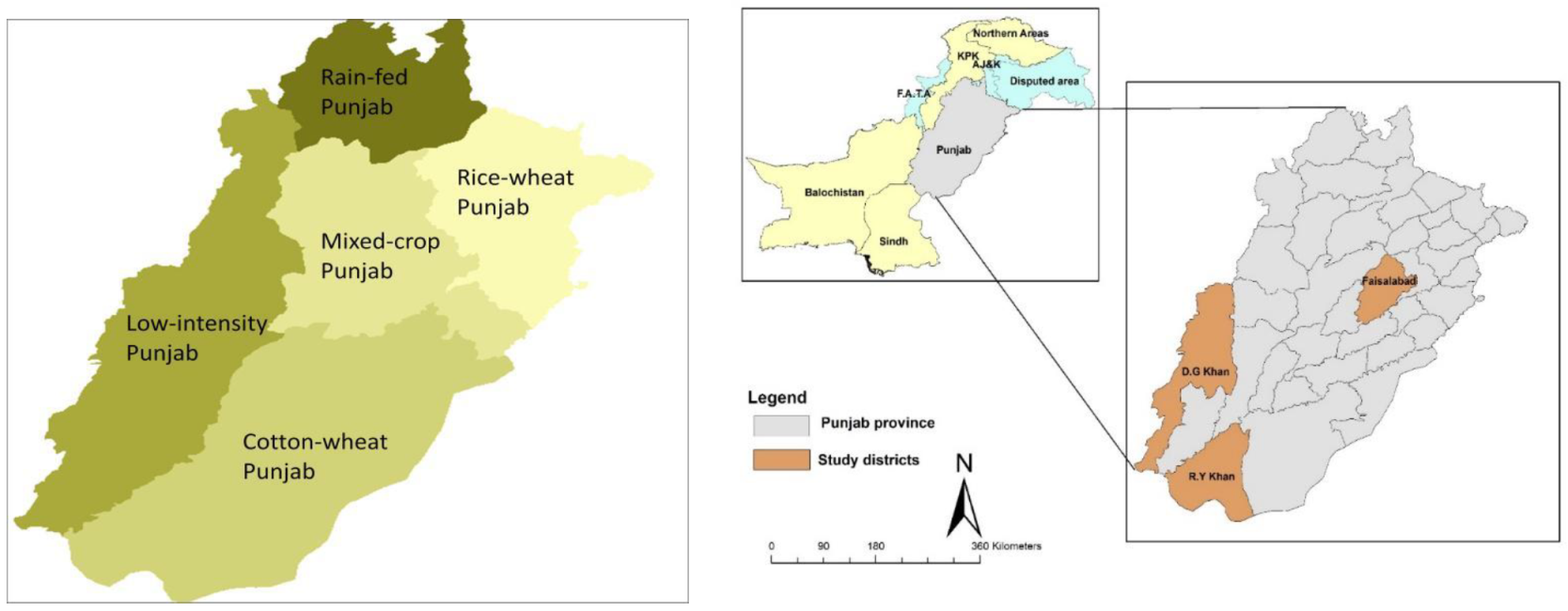

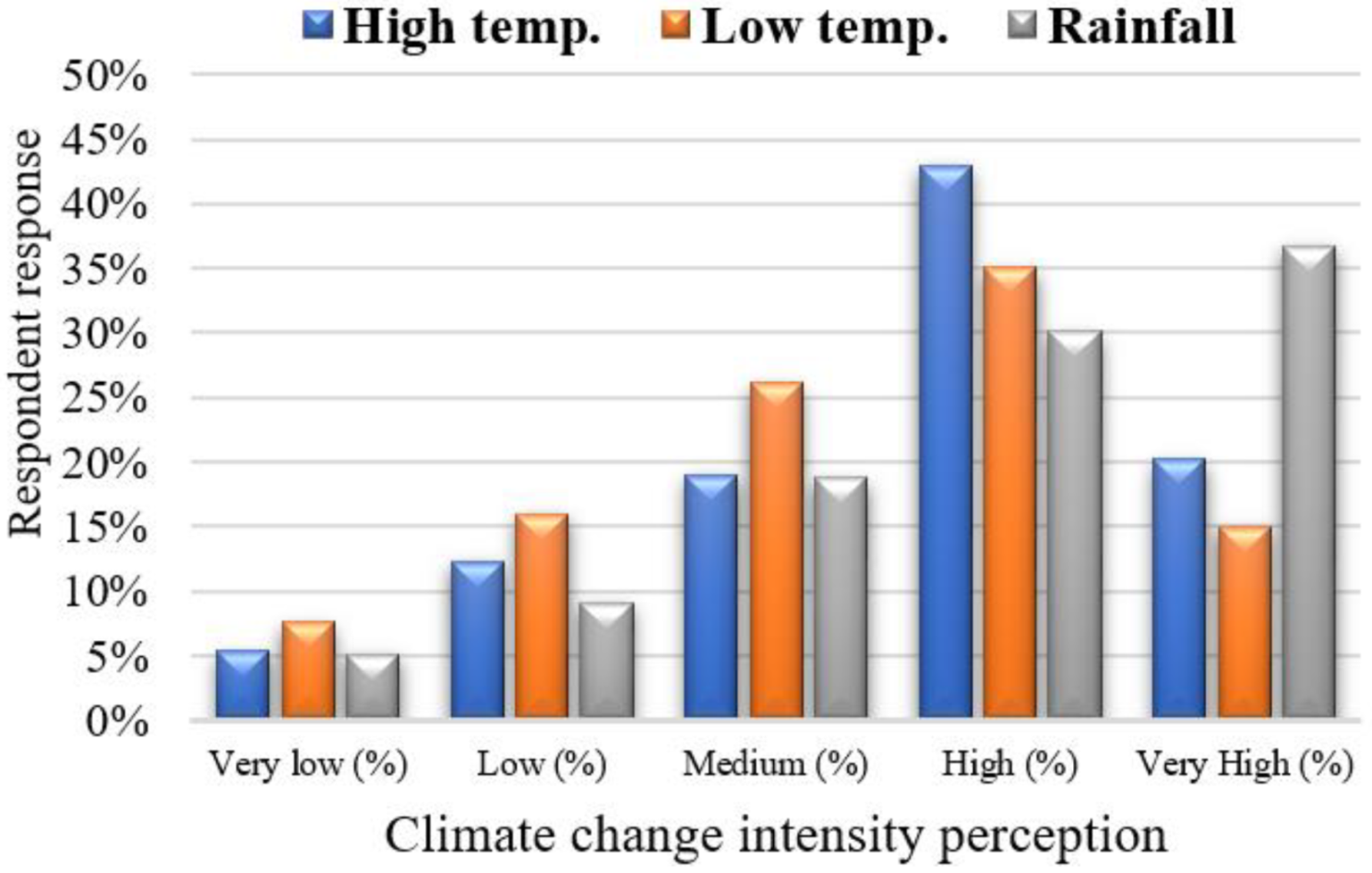
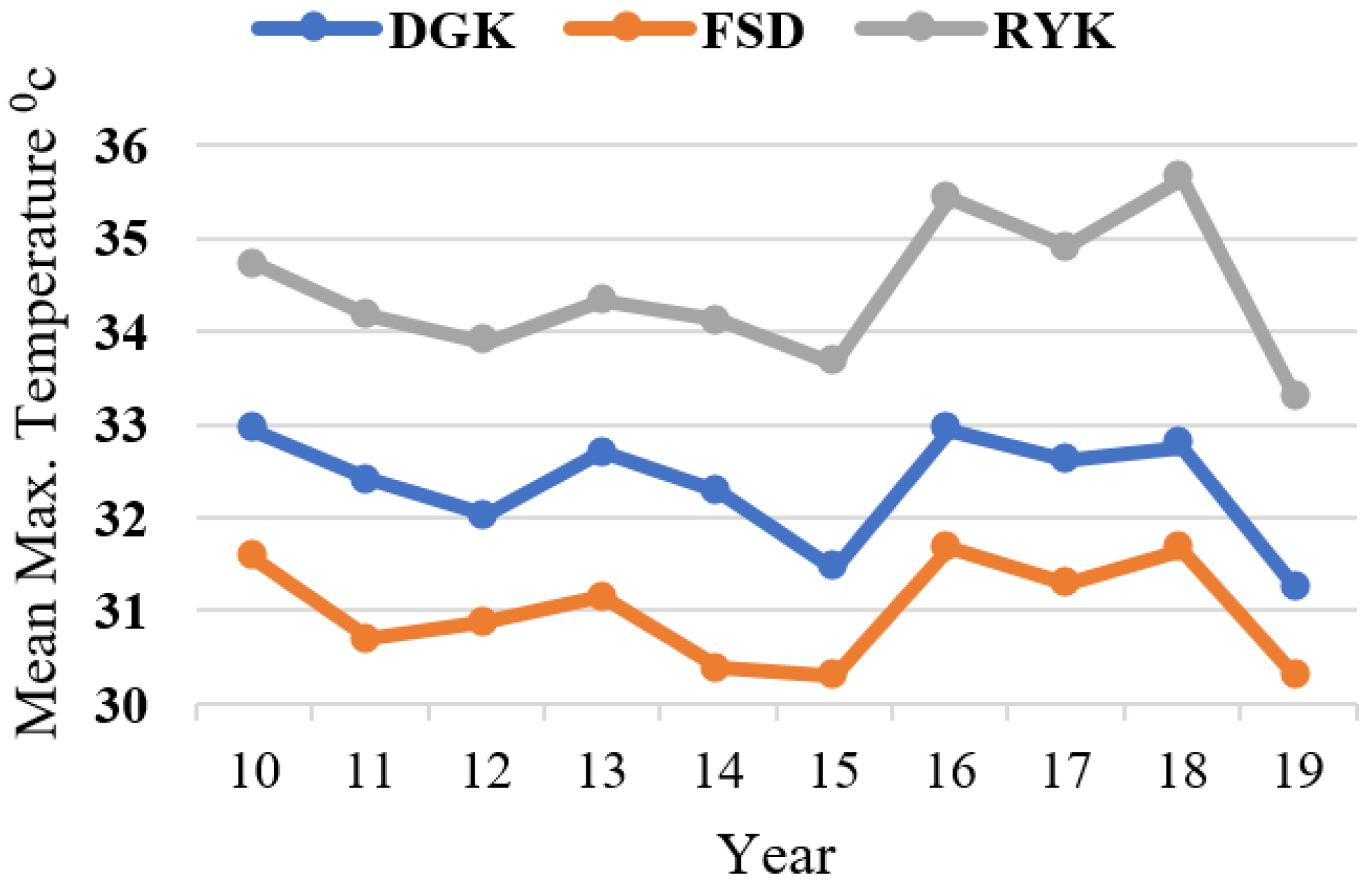
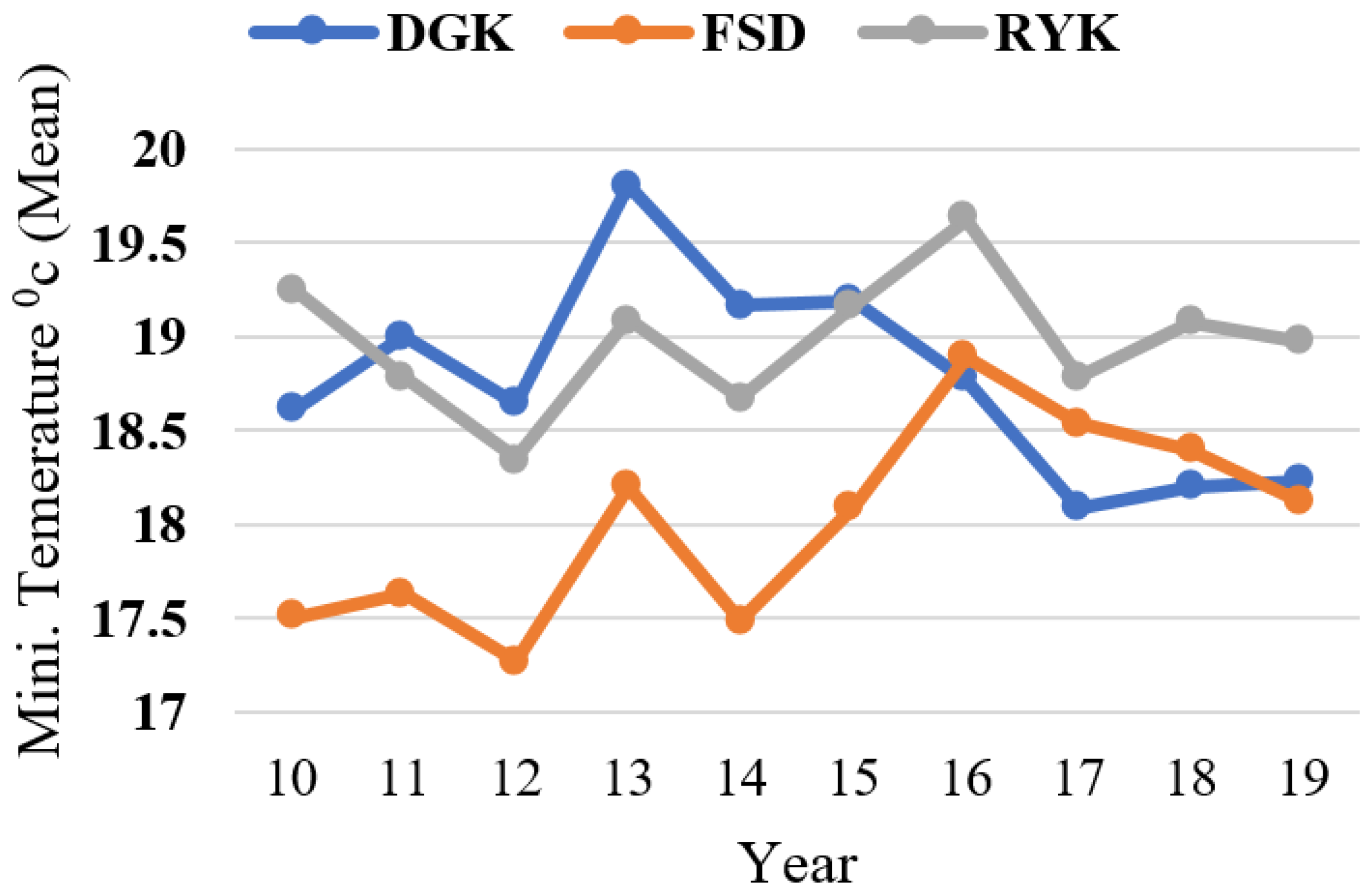
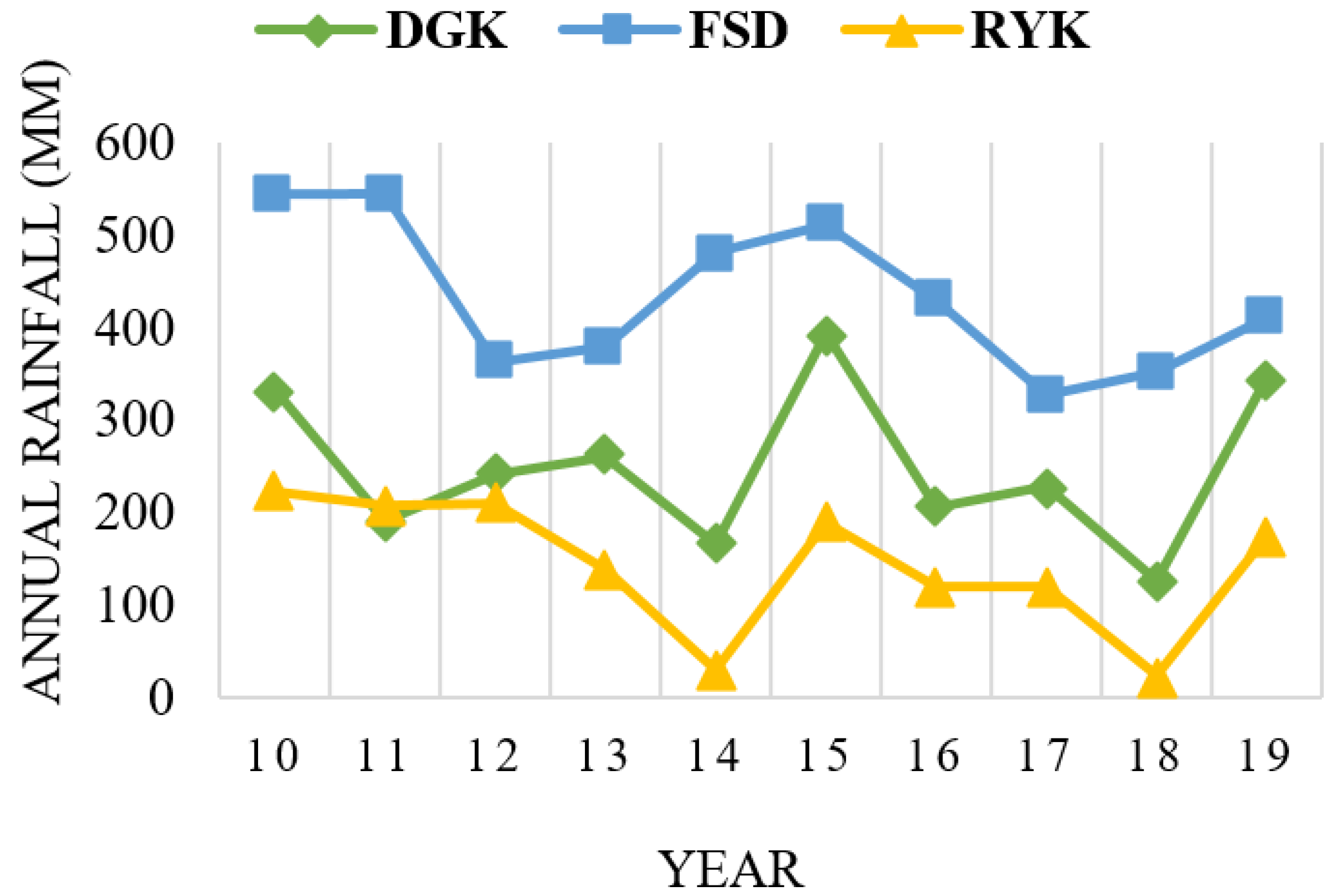
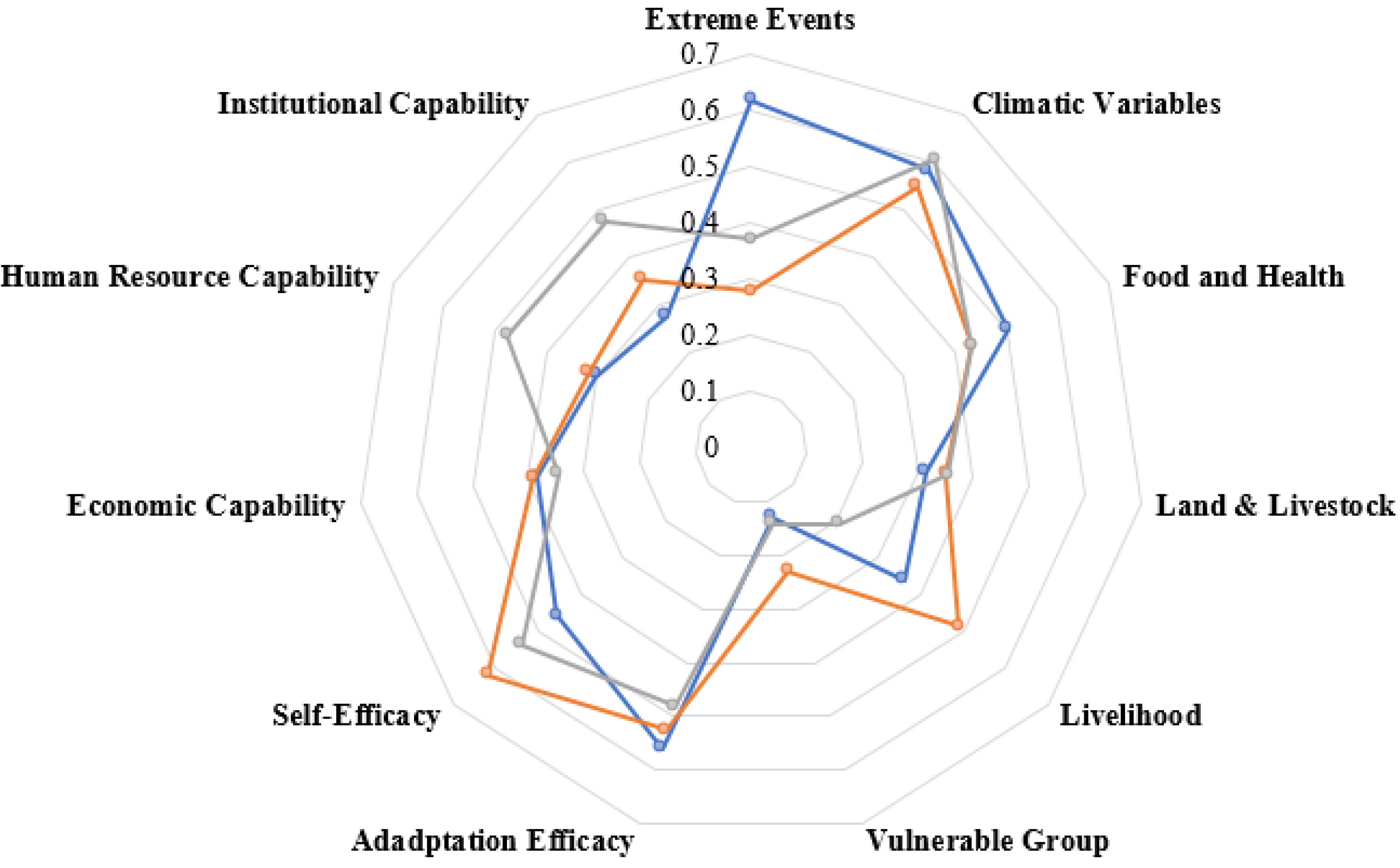
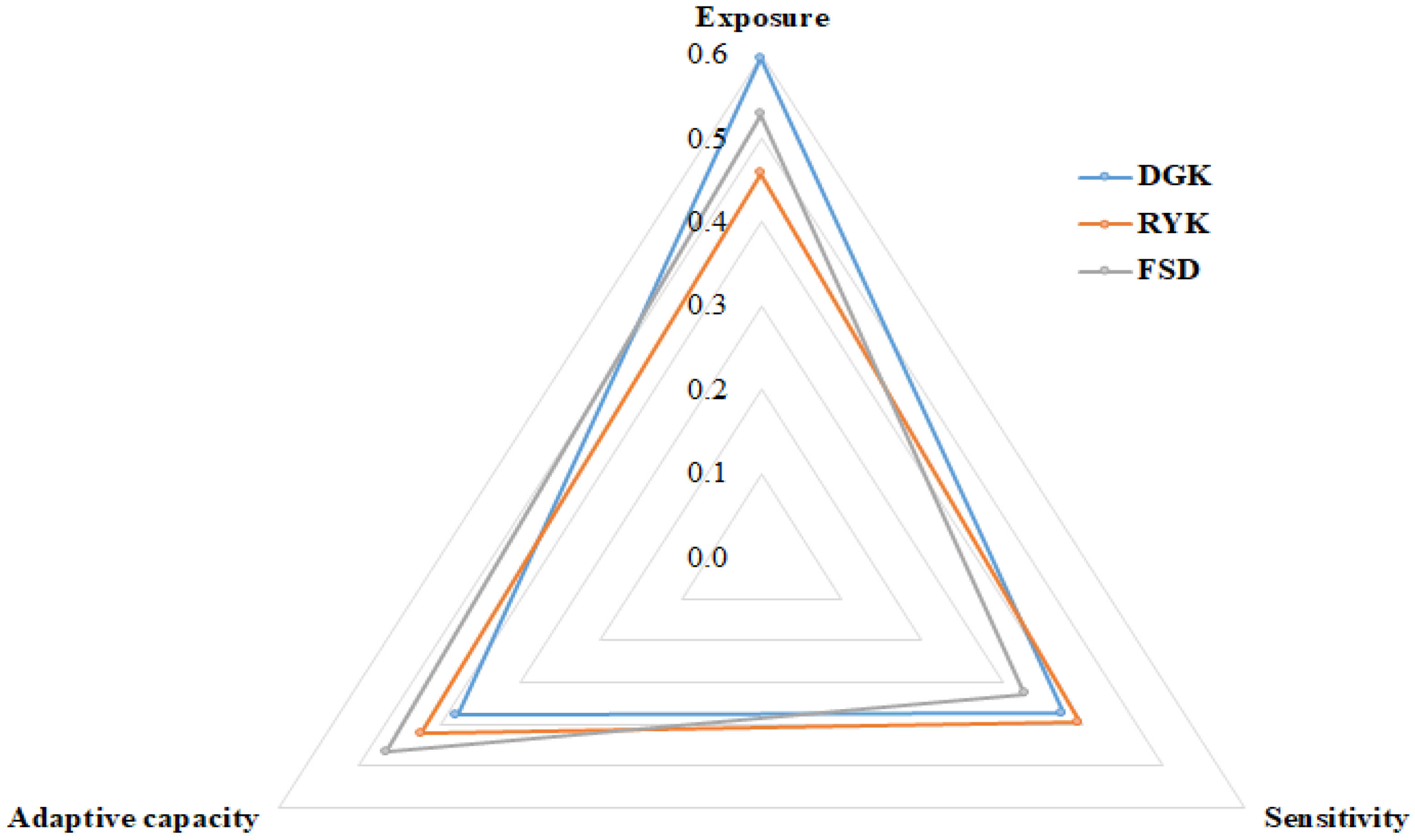
| Explanatory Variables | Expected Sign | Reference |
|---|---|---|
| Age (years) | −,+ | [71,72] |
| Experience (Years) | + | [63,70,73,74,75] |
| Family Size (Years) | + | [34,76] |
| Education | + | [74,75,77,78] |
| Household type | + | [11,34,76] |
| Area under fodder (Acre) | −,+ | [11,34,70] |
| Farm Assets (number) | + | [79] |
| Cooking fuel | −,+ | [80] |
| Basic repair facilities in village | + | [70] |
| Off-farm income | −,+ | [70,74] |
| Distance to market (km) | −,+ | [70] |
| Characteristics | Group | Agro-Ecological Zones (Study Area) | ||
|---|---|---|---|---|
| DGK | RYK | FSD | ||
| Age (years) | ≤30 | 11 | 17 | 17 |
| 31–50 | 82 | 89 | 86 | |
| ≥50 | 42 | 29 | 32 | |
| Experience (Years) | ≤20 | 63 | 61 | 74 |
| 21–35 | 65 | 56 | 52 | |
| ≥36 | 7 | 18 | 9 | |
| Age-wise Avg. Number of Family Members (Years) * | ≤15 | 4.71 | 3.96 | 2.44 |
| 15 ≤ age ≤ 65 | 7.03 | 6.04 | 4.56 | |
| ≥65 | 0.41 | 0.26 | 0.42 | |
| Total | 12.15 | 10.26 | 7.42 | |
| Education | Illiterate | 53 | 42 | 21 |
| Primary | 51 | 59 | 19 | |
| High school | 23 | 29 | 55 | |
| College/above | 8 | 5 | 40 | |
| Household type | Nuclear | 60 | 57 | 33 |
| Joint | 75 | 78 | 102 | |
| Area under fodder (Acre) | ≤2 acre | 109 | 130 | 117 |
| ≥2.1 acre | 26 | 5 | 18 | |
| Farm Assets (number) | Zero asset | 38 | 55 | 42 |
| 1–2 | 72 | 58 | 48 | |
| 3–4 | 25 | 22 | 45 | |
| Cooking fuel | Wood | 126 | 98 | 35 |
| LPG (and others) | 9 | 37 | 100 | |
| Basic repair facilities in village | No | 95 | 92 | 31 |
| Yes | 40 | 43 | 104 | |
| Off-farm income | No | 62 | 27 | 64 |
| Yes | 73 | 108 | 71 | |
| Distance to market (km) | ≤10 | 48 | 64 | 8 |
| 11–20 | 70 | 46 | 70 | |
| ≥21 | 17 | 25 | 57 | |
| Climate Change Events | Frequency | CCRPS | SCCRPI | Rank | ||||
|---|---|---|---|---|---|---|---|---|
| Very Low | Low | Medium | High | Very High | ||||
| Drought | 184 | 95 | 67 | 29 | 30 | 436 | 26.914 | 6 |
| High temperature | 22 | 50 | 77 | 174 | 82 | 1054 | 65.062 | 3 |
| Low temperature | 31 | 65 | 106 | 142 | 61 | 947 | 58.457 | 4 |
| Animal diseases | 27 | 47 | 81 | 116 | 134 | 1093 | 67.469 | 2 |
| Rainfall Pattern Change | 21 | 37 | 76 | 122 | 149 | 1151 | 71.049 | 1 |
| Flood | 186 | 96 | 47 | 55 | 21 | 439 | 27.099 | 5 |
| Contributing Factors | Major Components | Sub Components (Indicators) | Description | Relationship ** |
|---|---|---|---|---|
| Exposure | Extreme Events | Past 10 years observed drought intensity | Measured in a 5 point scale 1 (very low) to 5 (very high) | + |
| Past 10 years observed flood intensity | Measured in a 5 point scale 1 (very low) to 5 (very high) | + | ||
| Past 10 years observed animal diseases | Measured in a 5 point scale 1 (very low) to 5 (very high) | + | ||
| Climatic Variables | Past 10 years observed high temperature variation | Measured in a 5 point scale 1 (very low) to 5 (very high) | + | |
| Past 10 years observed low temperature variation | Measured in a 5 point scale 1 (very low) to 5 (very high) | + | ||
| Past 10 years observed rainfall variation | Measured in a 5 point scale 1 (very low) to 5 (very high) | + | ||
| Annual mean minimum temperature °C (2010–2019) PMD * | Mean standard deviation of monthly average minimum temperature | + | ||
| Annual mean maximum temperature °C (2010–2019) PMD * | Mean standard deviation of monthly average maximum temperature | + | ||
| Annual mean rainfall (2010–2019) PMD * | Mean standard deviation of monthly average rainfall | - | ||
| Sensitivity | Food and Health | Increase in the depth of subsoil water (past 10 years observation) | Percentage | + |
| Dairy yields/milk production/family (past 10 years trend) | Measured in a 3 point scale (1) no change (2) decrease (3) increase | + | ||
| Milk in diet (respondent past 10 years consumption trend) | Measured in a 3 point scale (1) no change (2) decrease (3) increase | + | ||
| Meat in diet (respondent past 10 years consumption trend) | Measured in a 3 point scale (1) no change (2) decrease (3) increase | + | ||
| Child growth performance (respondent past 10 years observation) | Measured in a 3 point scale (1) no change (2) decrease (3) increase | + | ||
| Amount of food consumed was below than desired quantity (respondent past 10 years observation) | Measured in a 3 point scale (1) No (2) yes for a couple a day’s (3) yes for a couple of weeks | + | ||
| Land and Livestock | Average land of household members (acre) | Own land/total number of family members | - | |
| Number of livestock losses in past 10 years (count) | Number | + | ||
| Have you experienced fodder shortage in past 10 years? | (1) Yes (0) otherwise | + | ||
| Change in total number of livestock during past 10 years | Measured in a 3 point scale (1) no change (2) decrease (3) increase | + | ||
| Livelihood | Took out children from school in past 10 years | (1) Yes (0) otherwise | + | |
| Have you changed the employment or work pattern in past 10 years | (1) Yes (0) otherwise | + | ||
| Applied for extended term of loan due to climate disaster in past 10 years | (1) Yes (0) otherwise | + | ||
| Vulnerable Group | Household members less than 15 years (count) | Number | + | |
| Household members greater than 65 years (count) | Number | + | ||
| Adaptive Capacity | Adaptation Efficacy | I am very positive about climate change adoption measures | Measured in a 5 point scale 1 (strongly disagree) to 5 (strongly agree) | - |
| I plan to adopt measures for climate change | Measured in a 5 point scale 1 (strongly disagree) to 5 (strongly agree) | - | ||
| Self-Efficacy | It is mostly up to me, whether or not to adopt climate change measures for my livestock | Measured in a 5 point scale 1 (strongly disagree) to 5 (strongly agree) | ± | |
| I have adequate ability (knowledge and skills) to implement climate change measures on my farm | Measured in a 5 point scale 1 (strongly disagree) to 5 (strongly agree) | - | ||
| Economic Capability | Financial and structural barrier prohibit me to adopt climate change measures | Measured in a 5 point scale 1 (strongly disagree) to 5 (strongly agree) | + | |
| Total number of livestock (count) | Number | - | ||
| Human Resource Capability | Adult family members (count) | Number | - | |
| Household head education (years) | Years | - | ||
| Livestock experience (years) | Years | - | ||
| Institutional Capability | Distance to reach the road (km) | Km | + | |
| Distance to market (km) | Km | + | ||
| Basic repair facilities available in village | (1) Yes (0) otherwise | - |
| Major-Components | Code | Sub-Components | Agro-Ecological Zones | ||
|---|---|---|---|---|---|
| DGK | RYK | FSD | |||
| Extreme Events | EXP1 | Past 10 years observed drought intensity | 0.535 | 0.141 | 0.131 |
| EXP2 | Past 10 years observed flood intensity | 0.543 | 0.128 | 0.285 | |
| EXP3 | Past 10 years observed animal diseases | 0.774 | 0.561 | 0.689 | |
| 0.617 | 0.277 | 0.369 | |||
| Climatic Variables | EXP4 | Past 10 years observed high temperature variation | 0.556 | 0.526 | 0.648 |
| EXP5 | Past 10 years observed low temperature variation | 0.594 | 0.472 | 0.687 | |
| EXP6 | Past 10 years observed rainfall variation | 0.758 | 0.578 | 0.735 | |
| EXP7 | Annually mean standard deviation of minimum temperature (2010–2019) PMD * | 0.538 | 0.352 | 0.526 | |
| EXP8 | Annually mean standard deviation of max temperature (2010–2019) PMD * | 0.599 | 0.762 | 0.557 | |
| EXP9 | Annual rainfall (2010–2019) PMD * | 0.461 | 0.600 | 0.490 | |
| 0.584 | 0.548 | 0.607 | |||
| Food and Health | SEN1 | Increase in the depth of subsoil water (past 10 years observation) | 0.493 | 0.410 | 0.293 |
| SEN2 | Dairy yields/milk production/family (past 10 years trend) | 0.541 | 0.456 | 0.470 | |
| SEN3 | Milk in diet (respondent past 10 years consumption trend) | 0.581 | 0.441 | 0.452 | |
| SEN4 | Meat in diet (respondent past 10 years consumption trend) | 0.515 | 0.441 | 0.433 | |
| SEN5 | Child growth performance (respondent past 10 years observation) | 0.407 | 0.370 | 0.415 | |
| SEN6 | Amount of food consumed was below than desired quantity (respondent past 10 years observation) | 0.481 | 0.481 | 0.526 | |
| 0.503 | 0.433 | 0.432 | |||
| Land and Livestock | SEN7 | Average land of household members | 0.078 | 0.150 | 0.160 |
| SEN8 | Number of livestock losses in past 10 years | 0.291 | 0.356 | 0.363 | |
| SEN9 | Have you experienced fodder shortage in past 10 years? | 0.541 | 0.607 | 0.415 | |
| SEN10 | Change in total number of livestock past 10 years | 0.344 | 0.289 | 0.485 | |
| 0.314 | 0.350 | 0.356 | |||
| Livelihood | SEN11 | Took out children from school in past 10 years | 0.370 | 0.496 | 0.207 |
| SEN12 | Have you changed the employment or work pattern in past 10 years | 0.519 | 0.519 | 0.244 | |
| SEN13 | Applied for extended term of loan due to climate disaster in past 10 years | 0.193 | 0.452 | 0.170 | |
| 0.360 | 0.489 | 0.207 | |||
| Vulnerable Group | SEN14 | Household members less than 15 years | 0.128 | 0.330 | 0.144 |
| SEN15 | Household members greater than 65 years | 0.138 | 0.130 | 0.141 | |
| 0.133 | 0.230 | 0.142 | |||
| Adaptation Efficacy | AC1 | I am very positive about climate change adoption measures | 0.591 | 0.594 | 0.541 |
| AC2 | I plan to adopt measures for climate change | 0.528 | 0.454 | 0.419 | |
| 0.559 | 0.524 | 0.480 | |||
| Self-Efficacy | AC3 | It is mostly up to me, whether or not to adopt climate change measures for my livestock | 0.493 | 0.685 | 0.596 |
| AC4 | I have adequate ability (knowledge and skills) to implement climate change measures on my farm | 0.420 | 0.557 | 0.481 | |
| 0.456 | 0.621 | 0.539 | |||
| Economic Capability | AC5 | Financial and structural barrier prohibit me to adopt climate change measures | 0.520 | 0.591 | 0.619 |
| AC6 | Total number of livestock | 0.247 | 0.190 | 0.071 | |
| 0.384 | 0.391 | 0.345 | |||
| Human Resource Capability | AC7 | Adult family members | 0.148 | 0.311 | 0.414 |
| AC8 | Household head education | 0.294 | 0.281 | 0.565 | |
| AC9 | Livestock experience | 0.465 | 0.351 | 0.446 | |
| 0.302 | 0.314 | 0.475 | |||
| Institutional Capability | AC10 | Distance to reach the road | 0.231 | 0.357 | 0.233 |
| AC11 | Distance to market | 0.304 | 0.378 | 0.428 | |
| AC12 | Basic repair facilities available in village | 0.296 | 0.319 | 0.770 | |
| 0.277 | 0.351 | 0.477 | |||
| Overall livelihood vulnerability index (LVI) * | 0.4309 | 0.4198 | 0.4237 | ||
| Contributing Factors | DGK | RYK | FSD |
|---|---|---|---|
| Exposure | 0.595 | 0.458 | 0.528 |
| Sensitivity | 0.375 | 0.395 | 0.328 |
| Adaptive capacity | 0.378 | 0.422 | 0.465 |
| LVI-IPCC * | 0.081 | 0.014 | 0.020 |
| Explanatory Variables | Response Variables | |||
|---|---|---|---|---|
| Model 1 | Model 2 | Model 3 | Model 4 | |
| Age (years) | −0.012 (0.017) | −0.031 (0.025) | −0.016 (0.023) | −0.035 (0.028) |
| Experience (Years) | 0.040 ** (0.017) | 0.038 (0.026) | 0.033 (0.024) | 0.035 (0.029) |
| Family Size (Years) | 0.070 ** (0.027) | 0.051 ** (0.020) | 0.059 *** (0.021) | 0.059 *** (0.020) |
| Education | 0.100 *** (0.033) | 0.306 *** (0.047) | 0.301 *** (0.045) | 0.165 *** (0.047) |
| Household type | 0.711 *** (0.245) | 1.076 *** (0.328) | 1.127 *** (0.326) | 0.606 * (0.364) |
| Area under fodder (Acre) | 0.143 (0.130) | 0.023 (0.129) | −0.025 (0.122) | 0.004 (0.121) |
| Farm Assets (number) | 0.106 (0.130) | −0.158 (0.160) | 0.020 (0.145) | 0.197 (0.153) |
| Cooking fuel | −0.230 (0.346) | −0.446 (0.444) | −0.713 * (0.413) | −0.090 (0.462) |
| Basic repair facilities | 0.610 ** (0.275) | 0.307 (0.359) | 1.199 *** (0.349) | 1.246 *** (0.426) |
| Off-farm income | −0.532 * (0.287) | −1.101 *** (0.352) | −1.041 *** (0.343) | −1.169 *** (0.380) |
| Distance to market (km) | 0.013 (0.018) | −0.001 (0.022) | 0.018 (0.021) | 0.028 (0.024) |
| DGK | 0.503 (0.392) | 1.931 *** (0.537) | 0.385 (0.478) | 0.424 (0.572) |
| RYK | 0.585 (0.380) | 1.751 *** (0.499) | 0.633 (0.449) | 1.171 ** (0.525) |
| FSD | Omitted | Omitted | Omitted | Omitted |
| Constant | −2.139 ** (0.882) | −3.932 *** (1.092) | −3.956 *** (1.065) | −4.270 *** (1.230) |
| Observations | 405 | 405 | 405 | 405 |
| Pseudo R2 | 0.143 | 0.251 | 0.295 | 0.244 |
| Log Likelihood | −236.623 | −165.155 | −170.806 | −138.495 |
| Prob > chi2 | 0.0000 | 0.0000 | 0.0000 | 0.0000 |
Publisher’s Note: MDPI stays neutral with regard to jurisdictional claims in published maps and institutional affiliations. |
© 2021 by the authors. Licensee MDPI, Basel, Switzerland. This article is an open access article distributed under the terms and conditions of the Creative Commons Attribution (CC BY) license (https://creativecommons.org/licenses/by/4.0/).
Share and Cite
Faisal, M.; Abbas, A.; Cai, Y.; Ali, A.; Shahzad, M.A.; Akhtar, S.; Haseeb Raza, M.; Ajmal, M.A.; Xia, C.; Sattar, S.A.; et al. Perceptions, Vulnerability and Adaptation Strategies for Mitigating Climate Change Effects among Small Livestock Herders in Punjab, Pakistan. Int. J. Environ. Res. Public Health 2021, 18, 10771. https://doi.org/10.3390/ijerph182010771
Faisal M, Abbas A, Cai Y, Ali A, Shahzad MA, Akhtar S, Haseeb Raza M, Ajmal MA, Xia C, Sattar SA, et al. Perceptions, Vulnerability and Adaptation Strategies for Mitigating Climate Change Effects among Small Livestock Herders in Punjab, Pakistan. International Journal of Environmental Research and Public Health. 2021; 18(20):10771. https://doi.org/10.3390/ijerph182010771
Chicago/Turabian StyleFaisal, Muhammad, Azhar Abbas, Yi Cai, Abdelrahman Ali, Muhammad Amir Shahzad, Shoaib Akhtar, Muhammad Haseeb Raza, Muhammad Arslan Ajmal, Chunping Xia, Syed Abdul Sattar, and et al. 2021. "Perceptions, Vulnerability and Adaptation Strategies for Mitigating Climate Change Effects among Small Livestock Herders in Punjab, Pakistan" International Journal of Environmental Research and Public Health 18, no. 20: 10771. https://doi.org/10.3390/ijerph182010771
APA StyleFaisal, M., Abbas, A., Cai, Y., Ali, A., Shahzad, M. A., Akhtar, S., Haseeb Raza, M., Ajmal, M. A., Xia, C., Sattar, S. A., & Batool, Z. (2021). Perceptions, Vulnerability and Adaptation Strategies for Mitigating Climate Change Effects among Small Livestock Herders in Punjab, Pakistan. International Journal of Environmental Research and Public Health, 18(20), 10771. https://doi.org/10.3390/ijerph182010771






